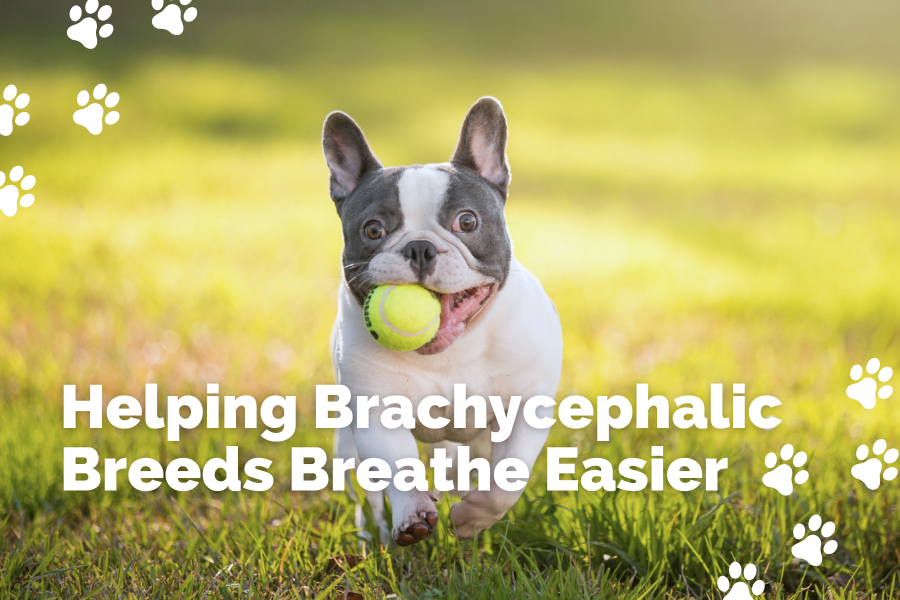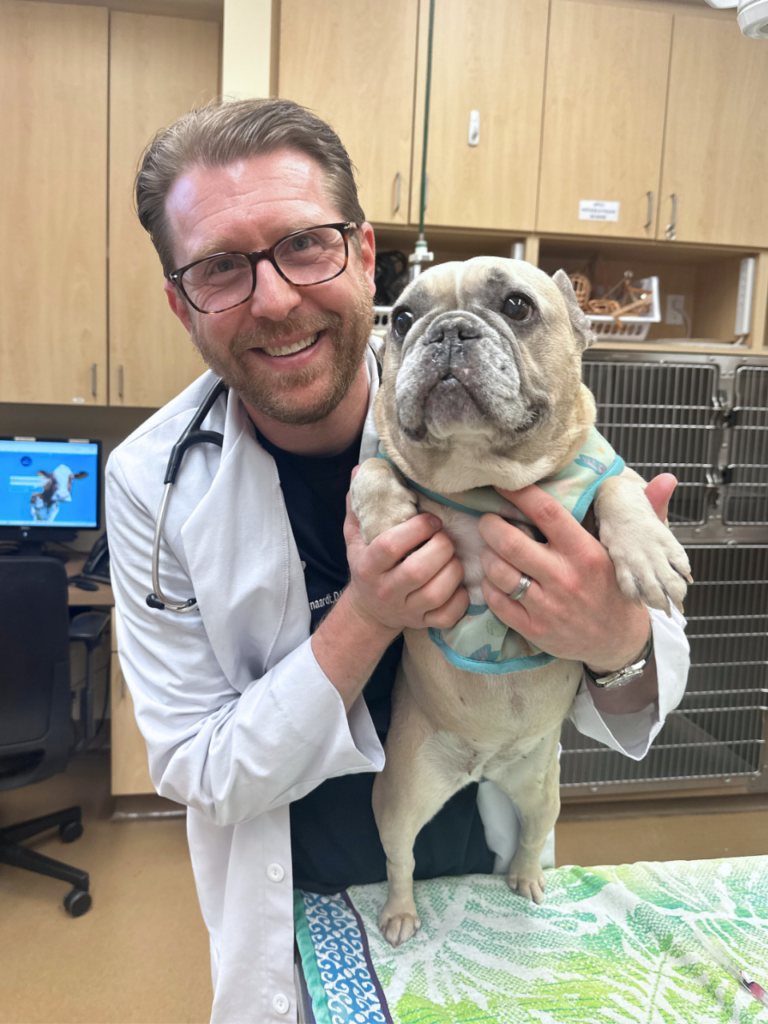
Brachycephalic breeds – the smooshed-face cuties like Bulldogs, Pugs, and Frenchies – are known for their unique appearance and lovable personalities. But as adorable as those squishy faces are, these breeds can face respiratory challenges due to their compact facial structure.
Understanding Brachycephalic Obstructive Airway Syndrome (BOAS)
The respiratory issues in these breeds fall under a condition known as Brachycephalic Obstructive Airway Syndrome (BOAS). Because of their short noses and compact skulls, brachycephalic dogs often have narrower airways and obstructed breathing passages, leading to difficulty breathing, snoring, exercise intolerance, and even serious health risks.
There are multiple surgical interventions that can be done to improve their quality of life tremendously, and thanks to the addition of Dr. Fynaardt to our veterinary team at Alicia Pet Care Center, we can offer the following surgeries.
Let’s dive in!
Common Surgeries for Brachycephalic Breeds
1. Stenotic Nares Surgery (Widening the Nostrils)
- What it Treats: Many brachycephalic dogs have small, pinched nostrils (stenotic nares) that restrict airflow.
- How it Works: This surgery widens the nostrils by removing small sections of tissue, making it easier for the dog to breathe through their nose.
- Benefits: Widening the nostrils allows more air to flow into the respiratory system, reducing the amount of energy needed to breathe. Dogs with corrected nares often show an increase in stamina and ease of breathing.

2. Elongated Soft Palate Resection
- What it Treats: The soft palate is a part of the throat that helps separate the nasal and oral passages. In brachycephalic breeds, this soft palate is often too long, causing it to partially obstruct the airway.
- How it Works: A surgeon trims the excess tissue from the soft palate with a laser, creating a clearer passage for air to flow from the nose to the lungs.
- Benefits: By reducing the obstruction in the airway, this surgery can greatly improve breathing comfort, especially during exercise or play. This surgery is commonly recommended for breeds with loud snoring, labored breathing, or coughing episodes.
3. Everted Laryngeal Saccules Removal
- What it Treats: The laryngeal saccules are small tissues just inside the voice box (larynx). In brachycephalic dogs, these saccules can become everted (turned inside out) due to negative pressure in the airway, further narrowing the breathing passage.
- How it Works: During this surgery, the everted saccules are carefully removed to open up the airway.
- Benefits: Removing the saccules can make a big difference for dogs with severe breathing difficulties, especially if they’ve had years of struggling for breath. This surgery can make everyday activities less taxing and help reduce inflammation in the airway.
A few other surgeries you may encounter with brachycephalic breeds include:
Caudectomy “Corkscrew Tail” surgery
- What it Treats: Dogs who need corkscrew tail amputation typically have chronic infections, sores on their tails, or even have difficulty moving if they have a pinched nerve. It’s most common in french bulldogs, pugs, english bulldogs- dogs who have a curly tail.
- How it Works: Whole or partial tail amputation to eliminate the deep skin folds.
- Benefits: The dog will experience much less pain and discomfort, and a reduction in the amount of skin infections after surgery.

Pictured is Dr. Fynaardt with his french bulldog patient who had corkscrew tail surgery and stenotic nares done by Dr. Fynaardt!
Urethral Prolapse
- What it Treats: When the urethra (the tube that carries urine from the bladder to outside the body), partially protrudes from the penis. It will appear as a red, donut shaped mass on the penis. This is most commonly seen in intact English Bulldogs or other brachycephalic breeds.
- How it Works: Ideally, in surgery we would “resect” and “pexy” at the same time. In a resection, the prolapsed tissue is removed. In a urethropexy, the urethra is anchored deeper in the penis to prevent prolapse. Often, the patient will be castrated for correction.
- Benefits: Surgery will relieve the discomfort, stop bleeding ,and reduces risk of future prolapses.
How to Know If Your Brachycephalic Dog Needs Surgery
If you’ve noticed that your dog struggles with labored breathing, frequent snoring, or tiring easily, it may be time to discuss these concerns with your veterinarian. They may recommend an evaluation for BOAS – at Alicia Pet Care Center surgery would benefit your pet’s quality of life.
Common signs that surgery may be beneficial include:
- Heavy or loud snoring
- Difficulty or noisy breathing, especially during activity
- Overheating or struggling to cool down after exercise
- Gagging, coughing, or choking sounds
- Fatigue during play or on walks
The Benefits of Surgery for Brachycephalic Breeds
These surgeries can have a profound effect on a dog’s quality of life. By reducing their struggle to breathe, your dog can enjoy everyday activities, engage in play, and even sleep more peacefully. With easier breathing, these dogs may also be at a lower risk for complications like heat stroke, heart strain, and respiratory infections.
Pet Insurance
Brachycephalic breeds are notorious for having various health issues, everything from allergies, to BOAS, being at a higher risk for heat stroke. We highly, highly, recommend getting pet insurance.
Final Thoughts
If you’re a proud pet parent of a brachycephalic breed, you know how much joy they bring to our lives, and they deserve to breathe easier. If you think your dog might benefit from an evaluation, our team is here in Mission Viejo, CA to help answer your questions and discuss options that best fit your pet’s needs. You can call us at 949-768-1313 to schedule an appointment or book online.
Your smooshy-faced friend deserves the best, and we’re here to support them in every way we can!

Recent Comments